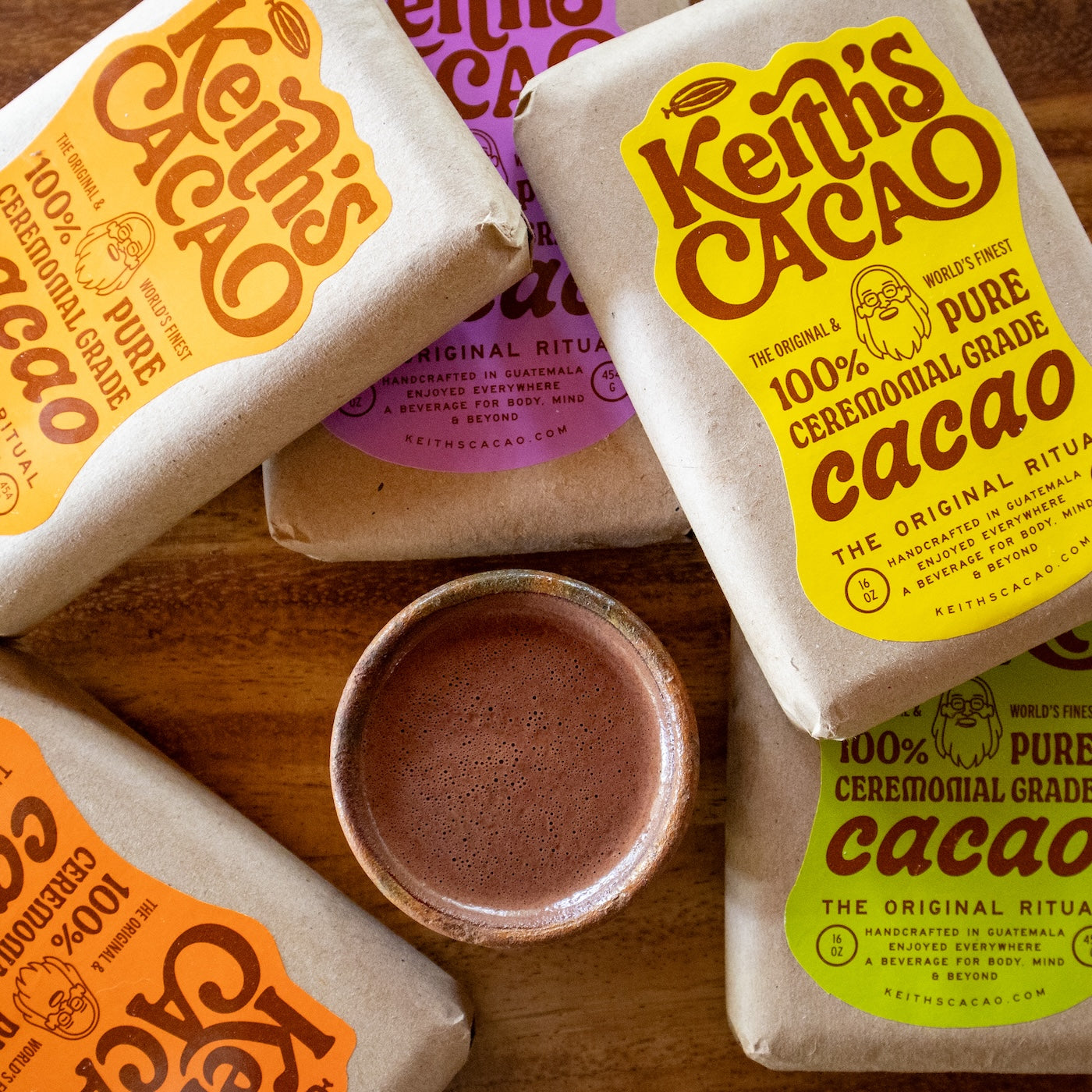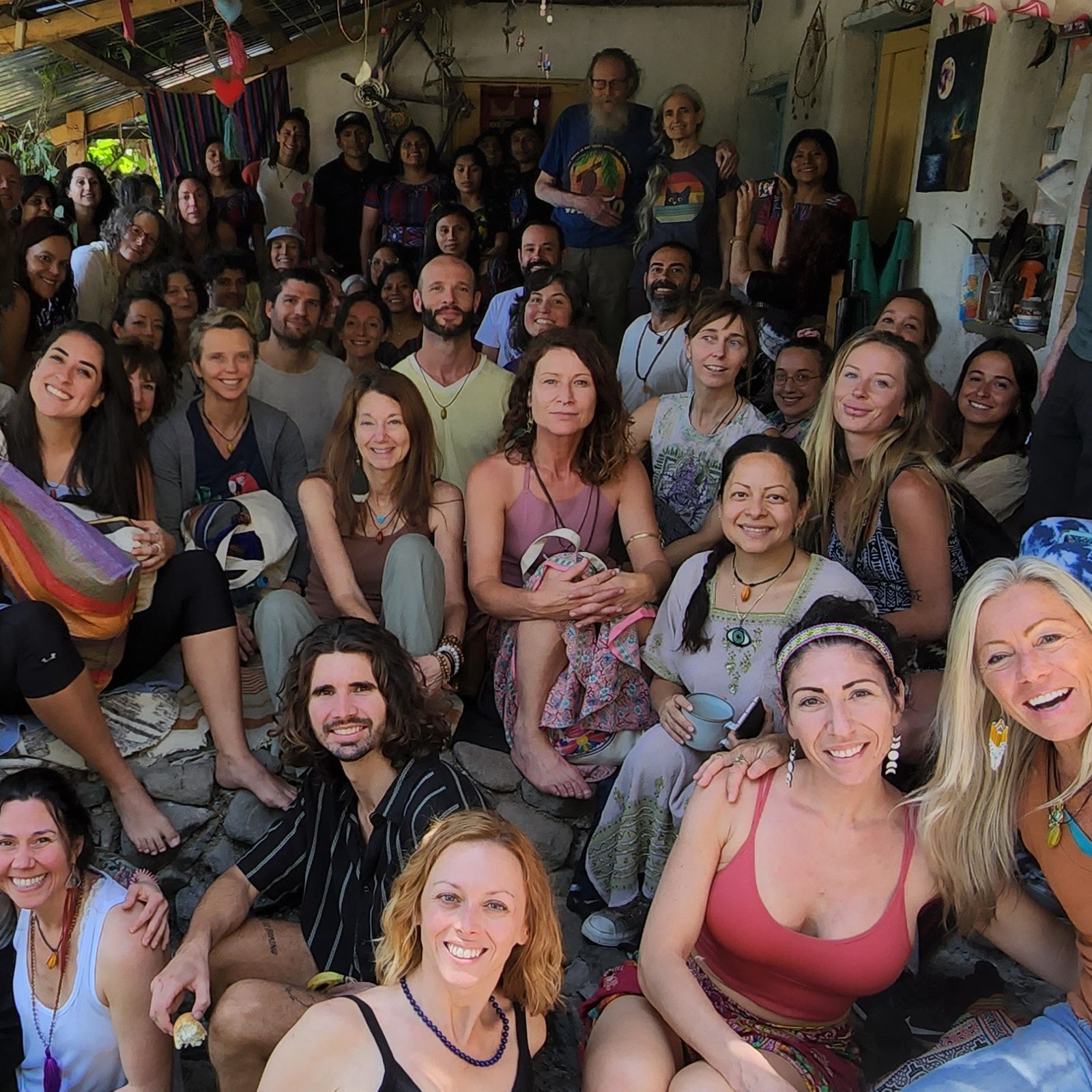Cacao beans | Ceremonial cacao | Keith's original writings | Keith's wisdom
Background on Cacao
This blog post is an extract from the original writings of Keith Wilson, the Chocolate Shaman. For more recent info on all things Ceremonial Cacao, visit our main blog.
Archeological evidence
According to both archeologists and Mayan spiritual elders, the Cacao Spirit was one of the most powerful deities in ancient Mayan cosmology. We know that Mesoamerica's ancient Mayans and Aztecs extensively used Cacao. However, we have no details about how they used it in rituals and ceremonies.
About 200 Cacao drinking jars dated 900 to 1000 years ago have been unearthed in and around the 800-room Pueblo Bonito, the largest and best-known great house in Chaco Canyon, northwestern New Mexico, USA. The jars are the same shape as Mayan Cacao drinking jars of the same period. The decoration is pure Chaco. The nearest available Cacao is more than 1,200 miles (1,920 km) south, in Mexico. At 8 to 10 servings per pound (454 g), that much Cacao would be heavy to carry! So why did the Ancestral Puebloans go through all that trouble to obtain Cacao when they had a local psychedelic right at their feet? And another two -psilocybin mushrooms and peyote cactus- much closer? What did they know? Were they simply using Cacao as a stimulant, as researchers suggest?
Cacao's Shamanic, Spiritual Use
Although one of this world's finest spiritual and shamanic partners, Cacao was ignored in the 1960s' resurgence of medicine plants and the psychedelic hype because it does not act like a psychedelic. Cacao does not take you on a trip but gently and lovingly will assist you in taking your own. It is the Cacao Spirit's choice to return at this time, and I am having fun being part of Her flow.
A lesser-known fact is that some contemporary indigenous cultures in Central and South America continue Cacao use in shamanic ceremonies, still preferring it to locally available psychedelics. Some use Cacao to facilitate a type of collective lucid dream, where they all journey together in another dimension.
Here's a story:
"Invited to visit, I walk past the lower trail guardians (they usually don't allow tourists). The shamans were not in the village. A 9-year-old leads the way up to the caves. With the limited Spanish on both ends, it was shared that they spent a month meditating in those caves before they went to war with the other peoples. When does the war begin? Last week. Over-shoulder glances to howling laughter. So they used the term 'war' because that is how they understand we solve our differences with other people. They sit in a circle, drinking Cacao, and as a group, meet the representatives of the other people, who drink theirs in another cave, in an adjacent dimension."
This is what the Cacao Spirit has taught me, and this is how I work. There is no ceremony to learn, and Cacao is no psychedelic to take you on a trip if you are not willing and able to go there.
When using Cacao, I suggest you intend such a journey. This site is not specific to shamanic use. However, the profound opportunities will become evident to you upon sampling our ceremonial grade Cacao. It is a significant albeit overlooked entheogen that many are already deeply connected with but not necessarily using in these ways. Yet, it is time. Cacao is calling, as the magical partner that it is!
Pure Cacao vs. Commercial Chocolate
Though doctors and healthcare professionals recommend eating dark chocolate, they rarely tell you that commonly available chocolate has little of the compounds recorded in the studies. Commercial processing, developed over the last 200 years, eliminates most of the active compounds from chocolate. Some 99% of these active ingredients are missing from brands such as Hershey's or Cadbury's, and an estimated 80% from Lindt or Green and Black. So, real Cacao has been all but forgotten.
Traditional vs. Hybrid Varieties
The instructions and recommendations on this site will work with anyone's Cacao. However, Cacao beans vary immensely in the amount of active compounds they contain. So most hybrid varieties (most of the world's commercial Cacao comes from hybrids) have only 25% of the beneficial nutrients and energetic compounds our Cacao has. Some hybrids are okay for ceremonial use, but I haven't used them in years, as I much prefer the older, traditional varieties.
The Cacao we sell is sourced by asking the Cacao Spirit where to find the best beans with the compounds and energies for our work. Not all batches have optimal genetics, fermentation, and drying. I have seen so much Cacao sold from as far apart as Mexico to Panama; all quite variable, and most, I would not truck home if it were free - though much of it could make a yummy chocolate treat! The next batch from the same producer in the same rainforest may not be quite right for me, and I won't buy it. There is that much variability - much more so than wine!
If you are buying 'organic' or 'fair-trade' Cacao, chances are, it is of the larger-seeded, processed, hybridized varieties and is not potent enough for ceremonial use, no matter how it is prepared. It is also likely to have lots of caffeine - giving too much buzz and no focus. A chocolate bar may indeed contain' 85% Cacao,' as it says on the package, for example, but that has nothing to do with how much and what percentage of compounds affecting consciousness are present in that Cacao. I knew of a great organic brand, but it completely changed when they started sourcing their Cacao differently. In my experience, most organic brands have a delightful taste and texture but are unsuitable for ceremony. Try it all to find out for yourselves. I have yet to meet a chocolatier who shows genuine interest in their product's active compound content. However, I have known them to buy our Cacao for personal use with their partners, despite having several thousand pounds of prime 'raw' Cacao in their storerooms!
Even the raw food folks often pay no attention to how their Cacao feels. The widely available 'raw' Cacao from Ecuador or Peru usually has 50-85% of the strength of native Guatemalan Cacao, which moved north through Central America with the shamans. (Others say that Cacao originated in Central America; in any case, botanists consider it a different variety). Most larger-seeded hybrids are a cross between these two varieties. Some 'raw' Cacao nibs work well in ceremony if you up the amount you use. However, the defatted 'raw' powder is much more variable. Be cautious, as increasing the amount of Cacao you consume to get enough psychoactive ingredients will make you nauseous.
The Cacao from Africa or Indonesia is almost exclusively hybrid. We have sent folks to the raw Cacao works in Bali, where David Wolfe now gets his Cacao; they tried it and ended up ordering our Cacao - both for their personal use and for ceremonies.
Many South American Cacao plant types, and the hybrid varieties bred from them, have a thicker pulp surrounding larger Cacao seeds. Over the millennia, these have been selected by people using that sweet-tart pulp as a traditional fruit snack and, more recently, as a premium smoothie ingredient. Look at the seed size for the Cacao you are buying; only as little as 5% of the world's chocolate supply comes from the smaller non-hybridized beans. The larger beans yield a high profit, are more easily peeled, and require 2-3 more fermentation time, thus generating more heat. I have seen 'raw' experts rave about the large-seeded hybrid beans just for their flavor. The Ecuadorians are proud of their 'Cacao Arriba Nacional,' cultivated for taste rather than shamanic use.
Caffeine Content
Be aware also that hybrids have significantly more caffeine than traditional varieties. Some people prefer that extra caffeine for the 'focus' and productivity it affords. I don't care for it with inner work or shamanic journeying - too buzzy, no real focus. Spiritual communities using that type of Cacao are cranked on the caffeine, which seems to show in the community dynamics. If you have ever had any 'aware' experience in an office environment, you can relate to caffeine being a facilitator for aggression. We have sent lots of different Cacao to a lab for testing, and our Cacao is by far the lowest in caffeine.
Spiritual Cacao, eaten as whole peeled beans, finger-dipped in agave nectar, is used in high-end yoga studios to facilitate that focus. There are 'Cacao bars,' where Cacao superfood concoctions are served instead of alcohol. People connect in the open-hearted energy Cacao fosters. It's so different from alcohol, which works as a social lubricant by suppressing fear - like a 'shot of courage.' By the way, tobacco suppresses anger and resentment, and marijuana suppresses sadness. I hear of traders on the stock exchange floor who prefer Cacao to coke for the clear focus it gives them without the downside of a subsequent crash and long recovery period. A writer I know tells me he can hold up to 9 separate storylines in his head and weave his paragraphs from that effortlessly and masterfully. Creative facilitation, anyone?
Cacao for Creativity
Indeed, as a medicinal 'drug,' pure Cacao that retains all its active ingredients is one of the most effective focus enhancers and creativity facilitators on the planet. There is an almost untapped market there, but it's growing. Cacao helps creative people remove the blocks to their flow. In my experience, adding coffee to a cacao brew moves it out of the creative-as-connective department and into the straight-stimulant department; but then, I don't have a caffeine habit. As a stimulant, Cacao synergy improves coffee; that's another market. I remember experimenting with emotional processing for a visiting student who was into coffee. You know mocha... this was woke-a! I sometimes put coconut milk, cardamom, chili, and vanilla in it. The Cacao Spirit tells me that it will be a few years before you will be able to find this type of Cacao in Starbucks. But you will...
With most plant medicines/teachers, you can extract one specific compound and call it the active ingredient. However, Cacao has many active elements working together. It is a very chemically complex food – various sources claim there are 300 to 1000 different compounds in Cacao. That is quite extraordinary in the plant or food world.
Keith's Cacao
The Guatemalan local wild rainforest variety Cacao we offer has a thin pulp and small seeds and requires less than half the fermentation time, generating less heat and acid in the process. According to research scientists, fermentation can greatly affect the compound content. The Cacao Spirit tells me that her preference is the short-time and small-batch fermentation of small seeds and small-scale Cacao production. If I could go out and buy ceremonial Cacao this good, I wouldn't be processing it myself!
We have introduced our Cacao to some Mayan shamans (that would be the Western term) who live about 2 hours away from us. Two women with whom we have been exchanging ceremonies and inner work. It has become a beautifully rewarding friendship. They really like the chocolate and are deepening their own way with the Cacao Spirit. Right now, there are only a handful of traditional Mayan practitioners using Cacao beyond occasionally nibbling on a few beans and throwing them in the fire. And couples who exchange Cacao beans in traditional weddings, just as we give chocolate on Valentine's Day. We are hoping to change that soon.

